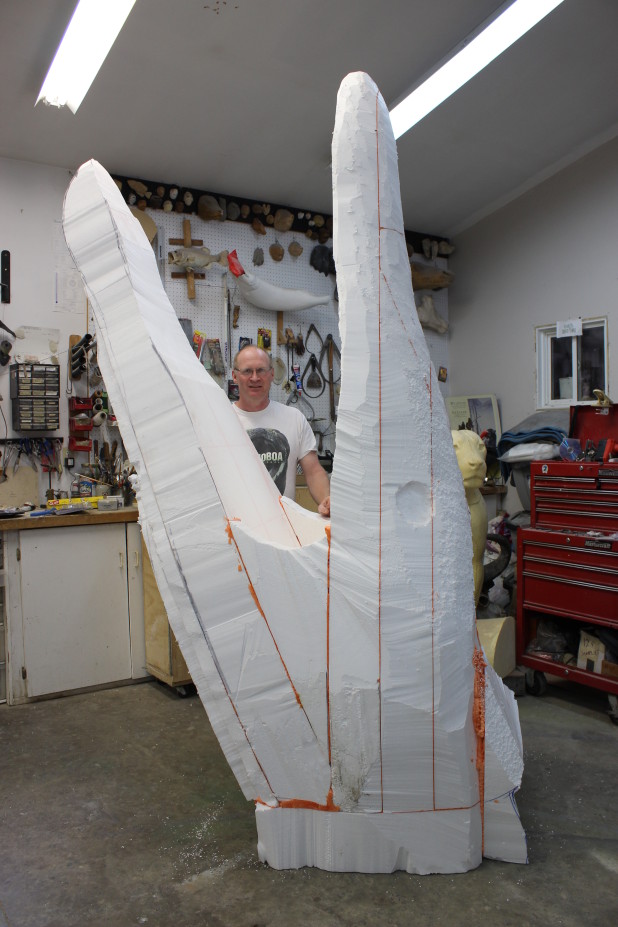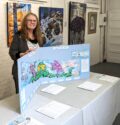Archive » Headline News » News
Art and science come together at Hockley Studios
November 12, 2014

By Nate Smelle
In his humble studio near Lake St. Peter, wildlife artist Kevin Hockley is taking a journey back in time. Bringing art and science together in his latest project, Hockley has been working on a life-size re-construction of a Liopleeurodon Ferox. This ancient sea creature roamed the seas that covered Europe from 160 to 155 million years ago during what is known as the Callovian stage of the middle Jurasic period. A similar species to the one rumoured to dwell in Scotland’s Loch Ness, this short-necked plesiosaurs grew to a length of more than 21 feet and was considered to be the apex predator of its domain. It was fiirst discovered in the late 1800s in the Oxford clay-beds in Great Brittan.
With more than 30 years of experience in museum display arts working on prehistoric creatures is not new for Hockley. Still, he enjoys the challenge
“We have done a few reconstructions in the past for pre-ice age creatures,” he said.
“We did a mastodon for Illinois State, we did an extinct jaguar, which is essentially the same as the modern ones. We also did a dire wolf, which is like a really big timberwolf, and some off the prey species these creatures fed on known as a flat-headed peckery, which is also now extinct. I made all of these out of synthetic fur. There are a lot of animals out there and I know a lot of them, but there are still many I do not know.”
Every project Hockley works on is completely unique. With an ever-changing muse inspiration comes easy for him. This project is exceptionally challenging though, because there has never been a complete skeleton found of a Liopleeurodon Ferox. Piecing together bits and pieces from different specimens found at a variety of locations he is able to extrapolate what an entire animal would have looked like., He has been working with a professor from Oxford University to maintain the highest degree of accuracy possible.
“I usually start with a skeleton, or whatever skeletal remains I can find. There are quite a few museums with skeletal reconstructions of them, so that’s a big help. I can also make comparisons to contemporary critters like crocodiles, and whales. This helps me to see what similarities there are and then I can build them up from there. It’s kind of like working from the basement up. It’s forensics at its highest level.”
Hockley got his start in taxidermy while working at the Royal Ontaio Museum (ROM) in Toronto, where he spent 12 years re-constructing various creatures. This experience gave him a deeper appreciation of animal anatomy, which in turn helped him evolve as an artist.
“I was very lucky in the ROM days when I worked at the museum to do a lot of exhibitions,” Hockley said.
“On the first floor we had a whole department called exhibit design services. There was 80 people employed at the time; everybody from carpenters to designers to graphic designers.”
His work is featured in museums and galleries across the country and around the world. It is currently on display from Panama to Alaska; and can be seen in exhibits at the ROM; the Canadian Museum of Nature in Ottawa; Royal Saskatchewan Museum in Regina; and the Smithsonian Institute, Washington DC.
The recreation will consist of a foam base, fused together and eventually sealed with fibreglass. Hockley plans to paint the creature with colours that would have blended the massive creature into its marine environment. This natural camouflaging is observed in contemporary creatures like whales, sharks and other marine life.
Too large to be shipped in one piece, once the Liopleeurodon Ferox is complete it will be dismantled and shipped in pieces to its new home at an aquarium in New Jersey. Hockley expects to have the creature ready for shipping by this Christmas.

















